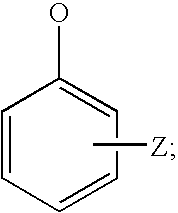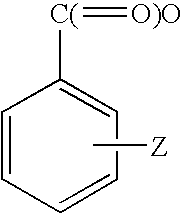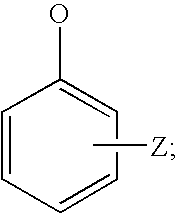Hydrolysable linkers and cross-linkers for absorbable polymers
a polymer and hydrolysable technology, applied in the field of linear and multiarmed hydrolysable linkers and cross-linkers and their synthetic intermediates, can solve the problems of not being able to use, not being able to meet the needs of use, and the majority of biodegradable polymers not soluble in water
- Summary
- Abstract
- Description
- Claims
- Application Information
AI Technical Summary
Benefits of technology
Problems solved by technology
Method used
Image
Examples
example 1
Synthesis of chloro-acetic acid 2-(2-chloro-acetoxy)-ethyl ester
[0338]
[0339]A solution of ethylene glycol (100 grams, 1.611 moles), chloro acetic acid (385 grams, 4.031 moles) and para-toluenesulphonic acid (1 gram) in toluene (750 ml) in a 2 lit 4 neck round bottom flask equipped with a mechanical stirrer and dean-stark apparatus was refluxed for 8 hours, cooled to room temperature. The toluene layer was washed with water (2×300 ml), 5% sodium bicarbonate solution (3×500 ml), water (2×300 ml), dried over sodium sulphate and distilled to get crude 1, which was purified by high vacuum distillation to get pure 1 (242 grams, 69.8%), which slowly crystallized to white crystals with a melting point of 44° C. The pure product 1 was also characterized using 1H NMR spectroscopy in CDCl3: δ 4.16 (s, 2H, CH2), 4.85 (s, 2H, CH2).
example 2
[0340]
[0341]To a solution of 4-nitrobenzoic acid (155 grams, 927 mmoles), triethyl amine (101.6 grams, 1.004 moles) in dimethylformamide (250 ml) was added 1 (60 grams, 279 mmoles) in small portions and stirred at 50° C. for 6 hours. The solids were filtered off, the dimethylformamide solution was added onto 5% sodium bicarbonate solution (1 lit), filtered crude 2, recrystallised in chloroform:methanol (1:1) to get pure 2(87 grams, 65.5%) as a off-white powder with a melting point of 116.5-118° C. The pure product 2 was also characterized using 1H NMR spectroscopy in CDCl3: δ 4.46(s, 2H, CH2), 4.88 (s, 2H, CH2), 8.30 (dd, 4H, Ar).
example 3
[0342]
[0343]The compound from Example 2(76 grams, 159.66 mmoles) was dissolved in dimethylformamide (150 ml) in a pressure vessel, Raney-Nickel (30 grams) added and the mixture stirred under an atmosphere of hydrogen (4 Kg) for 24 hours. The catalyst was removed by filtration, and 3 was precipitated by adding methanol, filtered, dried to get pure 3 (54 grams, 81.3%) as a off-white powder with a melting point of 183-185° C. The pure product 3 was also characterized using 1H NMR spectroscopy in DMSO-d6: δ4.32 (s, 2H, CH2), 4.78 (s, 2H, CH2), 6.10 (s, 2H, NH2), 6.60 (d, 2H, Ar), 7.78 (d, 2H, Ar).
[0344]Example-3—0.5 grams
Aldrich pH9 buffer—50 ml
Temperature—100° C.
[0345]Hydrolyzed in 5 hours
PUM
| Property | Measurement | Unit |
|---|---|---|
| Bioabsorbable | aaaaa | aaaaa |
Abstract
Description
Claims
Application Information
 Login to View More
Login to View More - R&D
- Intellectual Property
- Life Sciences
- Materials
- Tech Scout
- Unparalleled Data Quality
- Higher Quality Content
- 60% Fewer Hallucinations
Browse by: Latest US Patents, China's latest patents, Technical Efficacy Thesaurus, Application Domain, Technology Topic, Popular Technical Reports.
© 2025 PatSnap. All rights reserved.Legal|Privacy policy|Modern Slavery Act Transparency Statement|Sitemap|About US| Contact US: help@patsnap.com



